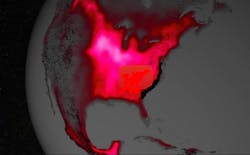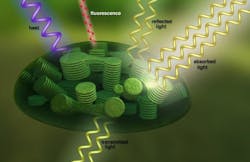Satellites monitor plant health using fluorescence maps from NASA
Greenbelt, MD--Scientists at NASA are using satellites to image the fluorescence signal emitted by living plants to measure what's occurring inside those plants at a cellular level. During photosynthesis, plants emit faint fluorescence signals that can be measured. Abundant fluorescence indicates active photosynthesis and a well-functioning plant, while low or no fluorescence can mean that the plant is stressed or shutting down. Now, satellite maps produced by Joanna Joiner and colleagues at NASA's Goddard Space Flight Center boast a 16-fold increase in spatial resolution and a three-fold increase in temporal resolution over the first proof-of-concept maps released in 2011 from a different satellite instrument. Improved global measurements could have implications for farmers interested in early indications of crop stress and ecologists looking to better understand global vegetation and carbon cycle processes.
"For the first time, we are able to globally map changes in fluorescence over the course of a single month," Joiner said. "This lets us use fluorescence to observe, for example, variation in the length of the growing season." Fluorescence measurements provide direct and immediate information about plant productivity. For example, the researchers saw plants start to shut down in the fall before their leaves turned colors. They also clearly detected early plant growth during the warm spring of 2012.
The maps are possible due to the development of a new way to identify the very faint fluorescence signal collected by the Global Ozone Monitoring Instrument 2 (GOME-2) instrument on Metop-A, a European meteorological satellite. Acquiring the measurement is complicated by the fluorescence signal mixing with that of sunlight reflected from Earth's surface and clouds, and the absorption of sunlight by gases in the atmosphere. To identify fluorescence, Joiner and colleagues took advantage of that fact that each of these signals has its own unique spectral signature akin to a fingerprint—whether from fluorescence, Earth's surface or the atmosphere. Match the fingerprint associated with fluorescence and scientists can tease out that data from the rest of the light.Detangling the signal from atmospheric influences was a complexity not present in the pioneering research in 2011, when Joiner and colleagues produced the first global maps that proved the concept of measuring global land plant fluorescence from space. That study relied on data from a spectrometer aboard a Japanese satellite called the Greenhouse Gases Observing Satellite (GOSAT). Researchers analyzed an unusually dark section of the infrared portion of the solar spectrum where there is little background light, making it possible to distinguish the faint fluorescence signal.
Despite its complexities, the new method allows for more frequent measurements capable of producing higher resolution maps. Previous observations with GOSAT relied on averaging the data over areas of 200 square kilometers every month. Now, with GOME-2, scientists average the data over areas of just 50 square kilometers about every 10 days. The study was published online for review in April in Atmospheric Measurement Techniques.
The research paves the path for fluorescence studies based on measurements from future atmospheric or fluorescent-specific observations. Such observations could come from NASA's Orbiting Carbon Observatory-2, a mission designed to measure carbon dioxide that will launch no sooner than July 2014, and the European Space Agency's Fluorescence Explorer mission, which could be selected in 2015 for launch toward the end of the decade.
SOURCE: NASA Goddard Space Flight Center; http://www.nasa.gov/content/goddard/seeing-photosynthesis-from-space-nasa-scientists-use-satellites-to-measure-plant-health/

Gail Overton | Senior Editor (2004-2020)
Gail has more than 30 years of engineering, marketing, product management, and editorial experience in the photonics and optical communications industry. Before joining the staff at Laser Focus World in 2004, she held many product management and product marketing roles in the fiber-optics industry, most notably at Hughes (El Segundo, CA), GTE Labs (Waltham, MA), Corning (Corning, NY), Photon Kinetics (Beaverton, OR), and Newport Corporation (Irvine, CA). During her marketing career, Gail published articles in WDM Solutions and Sensors magazine and traveled internationally to conduct product and sales training. Gail received her BS degree in physics, with an emphasis in optics, from San Diego State University in San Diego, CA in May 1986.

